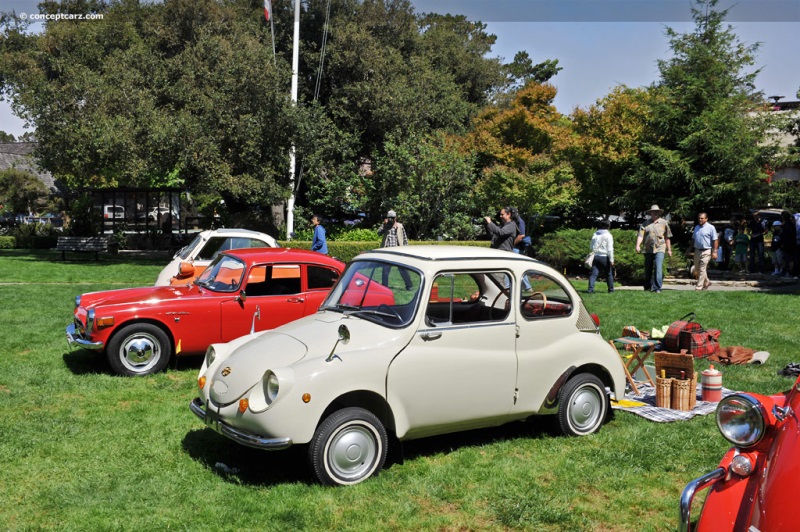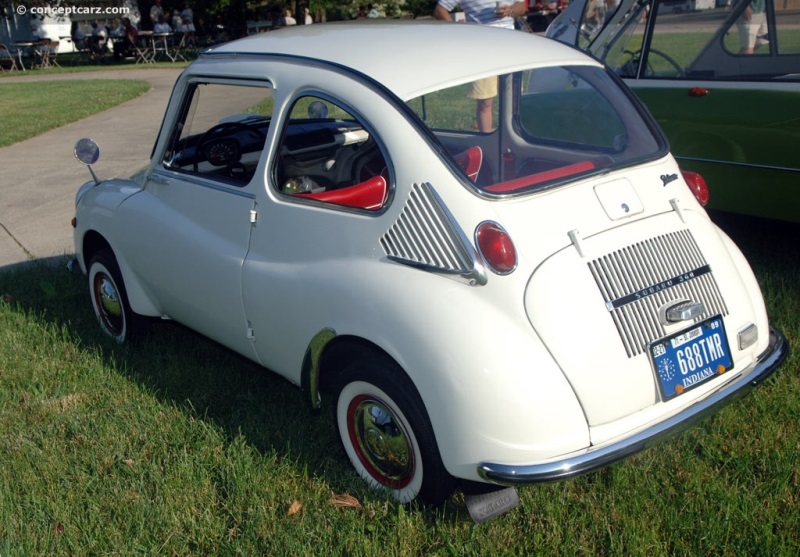


Coupe


Coupe
The Subaru 360 was introduced in 1958, with importation to the United States occurring nearly a decade later. The US importation was handled by Malcolm Bricklin. The 360 was powered by an air-cooled, 2-stroke engine that displaced 356cc and was mounted transversely in the rear of the vehicle. The layout was similar to the Volkswagen Beetle, but the 360 was much smaller, less popular, and less powerful. The small engine displacement meant it qualified for Japan's keicar class. The small engine produced 16 horsepower and provided 66 mpg. Near the close of production, the power had risen to 25 horsepower. A twin-carbureted engine option was later offered as optional, which increased horsepower to 36. The car featured a fiberglass roof panel and a monocoque construction frame. There were a variety of body styles that evolved over the years. The two-door coupe with seating for four was standard; a station wagon, dubbed the Custom, was one of the variations of the 360. A convertible, and two-sport models known as the Young S, were other variations.
By Daniel Vaughan | Jun 2008
The Subaru 360 was replaced, in 1971, by the Subaru R-2.
By Daniel Vaughan | Jun 2008
Though Subaru wasn't the first or best-selling of the post-war people's vehicles, the 360 fits the bill for city-friendly, economical, inexpensive, and even oddly stylish transportation for four passengers. The first automobile mass-produced by Fuji Heavy Industries' Subaru division was the Subaru 360 which was produced from 1958 until 1971. Featuring an air-cooled, 2-stroke 356 cc engine that was mounted transversely at the rear, the 360 was one of the more notable vehicles which adopted an arrangement that wasn't nearly as accepted in the world marketplace as the similarly shaped Volkswagen Beetle. On the small island of Japan, as the number of cars on city streets grew, traffic jams and parking headaches became more commonplace. Japan's Ministry of International Trade and Industry attempted to counteract the congestion and determined a strict size and specification limits for all classes of vehicles; the smallest and most city-friendly class was the Kei-jidosha, or K-class of cars. The K-class was first established in 1955 and required that the vehicles be no longer than 9 feet, 10 inches and have an engine with no more than 360cc of displacement. K-class cars were very popular, and purchasers of K-class cars enjoyed tax benefits and were allowed to park their vehicles on city streets overnight.In 1954 the first Subaru prototype was unveiled and would soon become the 1955 Subaru 1500. The first Japanese car to be built with unit-body construction, this conventional four-door sedan featured a 1,485cc water-cooled four-cylinder engine, though it was never widely marketed due to a lack of funding and sales network. The 1958 360 was Subaru's next automotive effort, and it was this vehicle that established Subaru as a distinctive and successful automaker.
To qualify for Japan's keicar class, the engine was of the 360 was designed with a capacity of less than 360 cc. The 360 body was built of monocoque construction and featured a fiberglass roof panel that was considered to be quite advanced in 1958. Originally in 1958, the engine featured 16 hp, and Subaru claimed 66 mph fuel economy, and by the end of production, power had increased to 25 hp with a 36 hp twin-carbureted engine as an option. Garnering plenty of attention, the unusual styling and ladybug-like shape of the two-door 360 sedan earned the nickname 'Ladybird' in Japan. Several variations of the 360 were produced and included a station wagon; called the Custom, a convertible, and two sports models. The sports models were known as the Young S, which had a slightly upgraded engine and transmission that featured four gears rather than three, bucket seats, and a tachometer along with a black, white-striped roof with a dent along the middle to put ones surfboard. The Young SS produced 36 hp and had dual carburetors and chrome bores. The Sambar was a flat-nosed truck and van introduced from 1961 onwards and was produced using the 360's engine, with arrangements very similar to the Volkswagen Transporter in a smaller size. Due to the pickup's small size for tight streets, ease to drive, speed, and great fuel economy, many small businesses grew very successful thanks to the Sambar. Throughout the years, the Subaru 360 changed only slightly. In 1963 the 360 received headlamp eyebrows, and in 1967 the 'Subarumatic' lubrication system was introduced and mixed the two-stroke engine's oil and gasoline automatically. Much like two-stroke SAAB 93s, earlier models required that the oil be pre-mixed with gas in the gas tank, and the Subaru's fuel tank lid doubled as a measuring cup to ensure the proper oil-to-gas ratio. A partially padded unit with an open glove compartment and small instrument cluster replaced the original bare metal dashboard. Pop-out rear quarter windows were also introduced in the same year, along with a vinyl-upholstered split front bench seat and map pockets now made the interior very passenger-friendly. Near the end of the 1960s, the 360 sedan still used a three-speed manual gearbox, though a four-speed manual was introduced as well as an optional three-speed-based 'Autoclutch' gearbox. This transmission was incorporated into a 'power unit' transaxle with the engine and differential.In 1969 the 356cc engine, which displaced a mere 21.7 cubic inches, and used a 61.5mm x 60mm bore and stroke, 6.7-compression and a Solex-type Hitachi sidedraft carb to make 25hp and 5,500 rpm and 25.3-lbs.ft of torque at 4,500 rpm which was a pretty impressive feat for that time period as more than one horsepower per cubic inch was rare for a two-stroke engine. During the early 1960s, a small number of Subarus were privately imported to the U.S. by individuals like many 'foreign' cars in the post-war period. The Sambar trucks and vans were sold by importers in Chicago and New York. Young entrepreneur Malcolm Bricklin imported the 360 to the U.S., but unfortunately, in 1969, Consumer Reports magazine branded the automobile 'Not Acceptable' due to safety concerns and lack of power, and sales collapsed. Bricklin started a successful chain of 'Handyman' building supply stores in Florida in the mid-1960s and entered into the motor scooter business after he took on the liquidation of a 25,000-unit inventory of Lambretta scooters. Bricklin purchased a motor scooter company in Boston, and once its inventory was gone, he approached Fugi for more scooters to sell, and there learned that they were discontinuing production of the Rabbit and selling the tooling. It was during a trip to Japan that he attempted to purchase the works and was introduced to the 360. For $75,000, he and his friend and business partner Harvey Lamm were able to buy the rights to distribute Subaru vehicles in the U.S. In 1969, with 20 dealers on the East Coast and 60 in California, the Philly, PA-based Subaru of America was born.
Despite a slow start in 1968, with a low 332 sales, just under 10,000 Subaru 360s and their derivatives were officially imported to America in the initial three years. Bricklin decided to sell his shares of Subaru of America and also sold his importation rights back to Fuji Heavy Industries in 1971. Bricklin took unsold 360s and created a driving trial on a private track, and for $1, a driver could race a 360 against a 'best' time. Multiple rumors floated about that the Subaru 360s were being tossed overboard or being shredded to pieces, or that many 360s sat on dealers' lots for two or three years without ever being purchased. But despite all of this bad press, Subaru gained popularity in the U.S. with its later models and continues to remain profitable there today. The more advanced (though less popular) R-2 replaced the Subaru 360 before being quickly superseded by the long-lived Subaru Rex model. The 360 remains a popular subject for collectors in the 2000s, and model cars among other mini-cars such as the Morris Mini and the 2CV. As one of the smallest vehicles to attract a significant following from the 1960s to early 1970s, the 360 was never significant in North America, it is still quite popular in Japan and still appears in Japanese anime series such as Pokemon and Get Backers.By Jessica Donaldson
With its four-person capacity, air-cooled, 356cc, two-cylinder, two-stroke, 16hp engine, and 2995mm overall length, the 360 fell into the K-class mold. Following the 1500 with unit-body construction, the 360 used a fiberglass roof insert to keep the weight down. The early version could reach 51 mph, and a 75 mpg capacity was claimed.
The 360 was marketed much like the Volkswagen, Subaru of America's 'Cheap and Ugly Does It' was a sales slogan cannily close to VW's famous 'It's ugly, but it gets you there.' The 360 did beat the Volkswagen with a shocking $1,297 stick price compared to the VW's $1,699 price.
Similarly Sized Vehicles
from 1969
Similarly Priced Vehicles
Subaru Monthly Sales Volume
March 2024
61,297
February 2024
47,189
January 2024
44,510
November 2023
53,327
October 2023
53,772
September 2023
56,335
August 2023
56,407
June 2023
55,168
May 2023
54,531
April 2023
51,014
February 2023
45,790
January 2023
44,373
1969 Subaru 360 Vehicle Profiles
Recent Vehicle Additions
Performance and Specification Comparison
Price Comparison
360 Specification Comparison by Year
Year
Production
Wheelbase
Engine
Prices
Related Automotive News

London Concours 2023 to feature spectacular Porsche RS celebration
50 of the finest Porsche 911 RS models to be assembled in the centre of London for one day only for this Junes automotive garden party
Display to celebrate diverse history of Porsche 911 RS, perhaps the most iconic performance line of all
Fabulo...

From Lucybelle to DHL: Historic Porsche Competition Cars Race to Gooding & Company's Pebble Beach Auctions
The very best of Porsche excellence will come to Pebble Beach with a 1959 Porsche 718 RSK, a 1969 Porsche 90802, a 2007 Porsche RS Spyder Evo, and more.
Gooding %26 Company, the official auction house of the Pebble Beach Concours dElegance®,...

The Ultimate Beach Cruiser: The 1974 Volkswagen Acapulco Thing
The Volkswagen Type 181 – commonly referred to as The Thing – has always been a fun summer classic for drivers who enjoy a cool and wildly original type of ride. The removable doors, retractable soft top and folding windshield provided a driving experience...

BRUCE MEYERS TO CELEBRATE 50TH ANNIVERSARY OF ICONIC MEYERS MANX BY RACING IN 2014 NORRA MEXICAN 1000 RALLY
After months of preparation and with the support of an industry it helped create, Meyers Manx Inc. today proudly announced details of a new project to celebrate the cars 50th anniversary next month. It is entering company founder Bruce Meyers in next...

Mopar Ram Runner Wins Truck Duel in the Desert
Leaves Ford SVT Raptor in the Dust
Mopar Ram Runner 33 seconds faster than Ford SVT Raptor on punishing 4.73-mile loop
PickupTrucks.com declares Mopar Ram Runner the winner
May 30, 2012 , Auburn Hills, Mich. - This showdown was at sunrise.
The...








